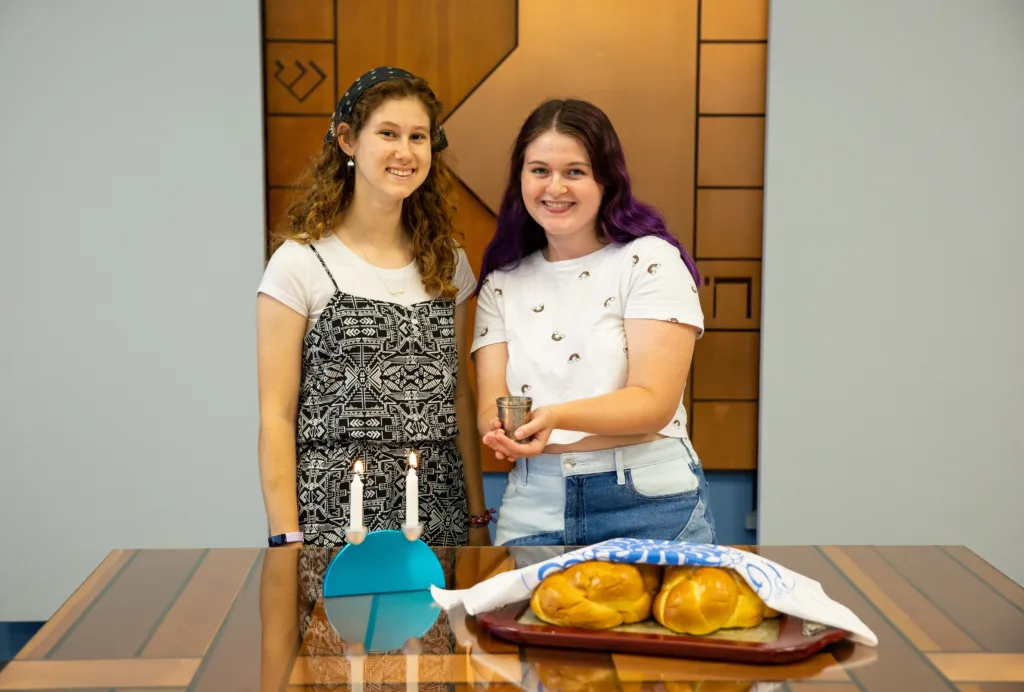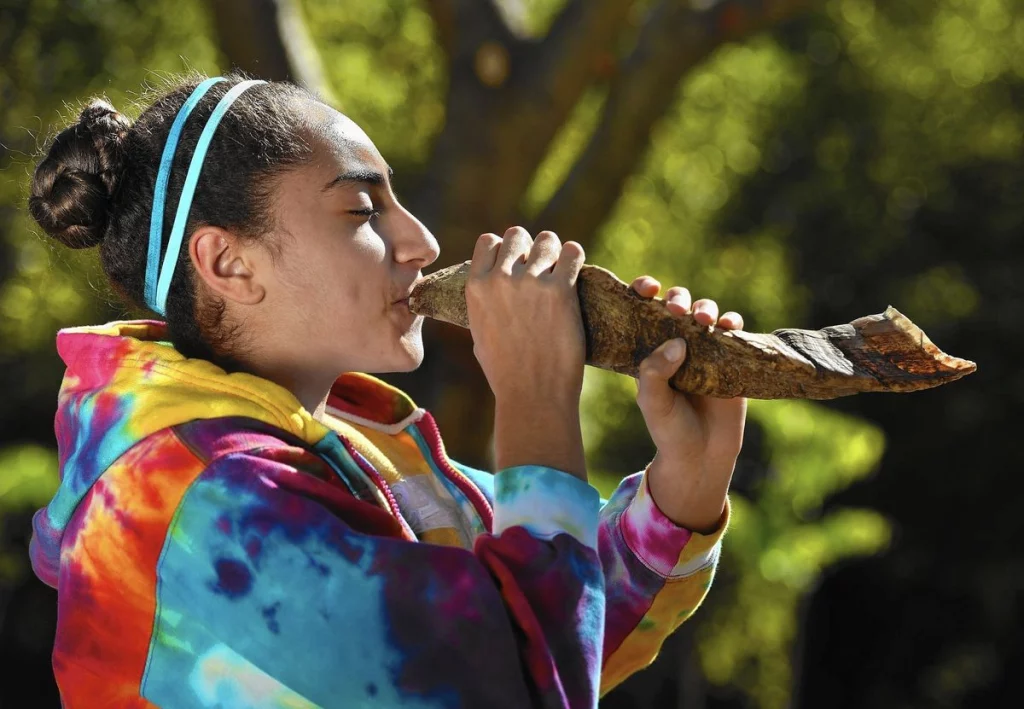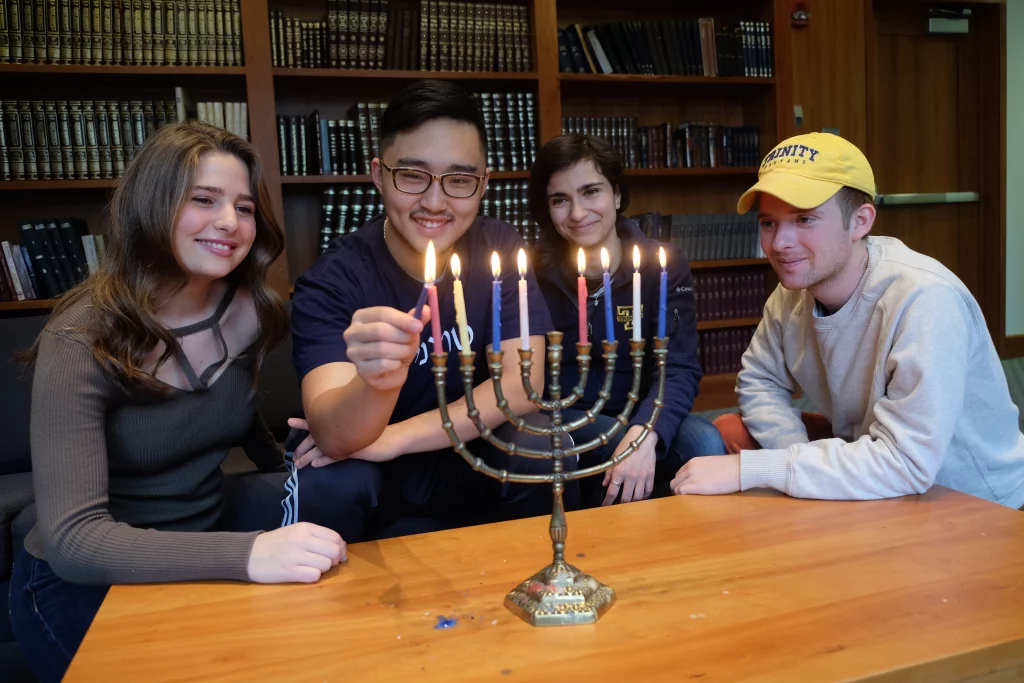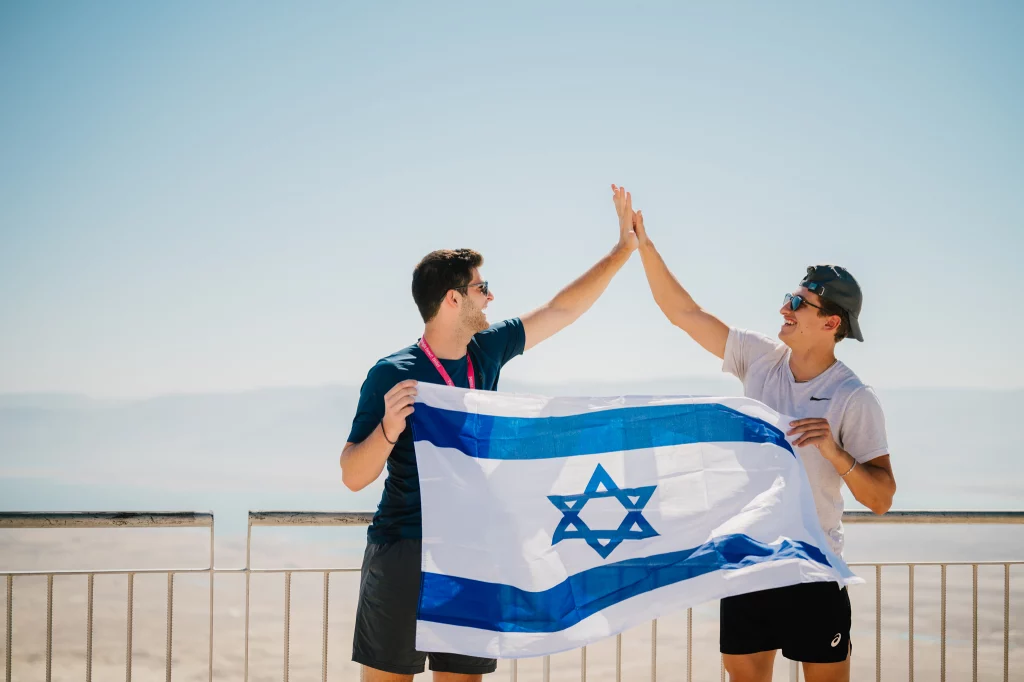Jewish Holidays at Hillel
Holidays are critical times for students to connect with Jewish campus life. Hillel infuses new meaning into traditions and holiday celebrations, inspiring students to celebrate Jewish life on campus and beyond.

To nurture exploration and engagement, Hillel professionals provide opportunities for year-round expressions of Jewish life. They connect with college students who represent an array of different practices, knowledge levels, and affiliations. Often, students must balance their religious practices with their academic requirements. Rosh Hashanah may fall on the first day of school. The first Passover seder might be celebrated at the height of midterms. Hillel professionals are there for students, ensuring they can uphold their Jewish traditions with more meaning and less stress.
Shabbat, which begins at sundown on Friday and lasts through nightfall on Saturday, is the weekly day of rest for the Jewish people. Traditionally, Shabbat begins with lighting candles and continues on with a Sabbath meal, including wine and challah, a braided bread. Each Saturday morning, the weekly Torah portion is read aloud.
When Shabbat ends on Saturday evening at sundown, a havdalah (separation) ceremony uses wine, spices, and a braided candle to help distinguish Shabbat from the other six days of the week. After the blessing and other prayers, we wish each other Shavua Tov, a good week.
Shabbat at Hillel takes many forms, from traditional prayer services to meditation with peers. Students may celebrate in the Hillel building, a campus dorm room, and even at Greek houses with “Shabbat Kits,” complete with candles, grape juice, and challah provided by campus Hillels.
Rosh Hashanah, literally translating to “head of the year,” marks the beginning of the Jewish year. The two-day festival is a time of serious introspection, personal growth, and spiritual rebirth. The Season of Repentance, beginning with Rosh Hashanah, encourages Jews to seek forgiveness from those they have wronged over the past year and reflect on what the new year might bring.
Traditionally, Rosh Hashanah is celebrated with special prayer services, including the blowing of the shofar, a ram’s horn. Festivities also include eating traditional and symbolic foods, such as apples and honey, round challah, and in some communities, fish heads.
Many Jews also throw bread in the water to symbolically cleanse themselves of their sins during the ritual known as tashlich. In the 2010s, Suncoast Hillels created “Reverse Tashlich”, a modern twist on this age-old ritual that calls on Jewish communities to switch the process and remove these human “sins” from the water in waterfront cleanups.
On campus, Rosh Hashanah often coincides with the beginning of the academic year, enabling Hillels around the world to create warm, welcoming, and reflective Jewish spaces.
Yom Kippur, the Day of Atonement, is the culmination of the Jewish High Holidays. The most solemn day of the Jewish year, Yom Kippur is traditionally observed by praying and fasting. The day is an opportunity to reflect on the previous year and consider how we might become better people in the year ahead.
On campus, Hillel professionals around the world work to give students access to the spiritual resonance of Yom Kippur, helping students tap into the deep power of Jewish tradition. Many Hillels offer a variety of Yom Kippur services, often led by students, and meals to break the fast.
Sukkot commemorates our ancestral journey in the depths of the desert. The weeklong festival is observed by building and spending time in a sukkah, a temporary outdoor structure, to connect to the harvest season. Along with eating meals in the sukkah, we lift and shake the lulav (a bouquet made up of a palm branch, three branches of myrtle, and two willow branches) with an etrog (a fragrant, yellow or green bumpy citrus fruit also known as a citron).
Shemini Atzeret, which falls on the day after Sukkot ends, is when the prayer for rain is added to our daily, structured prayers. Rain sustains crops and is integral to strength and survival, as water levels are dangerously low in Israel.
On Simchat Torah, we celebrate the completion of the yearly cycle of Torah readings and begin it anew. This symbolizes that our passion for spiritual completeness never ends. We mark our celebration by dancing and singing with the Torah.

Sigd, an Ethiopian Jewish festival, marks the renewal of the covenant between God and the Jewish people. Years ago, in Ethiopia, Jews would climb a mountain 50 days after Yom Kippur to fast and pray for their return to Jerusalem. For thousands, that dream was actualized in the mid-20th century with rescue airlifts from Ethiopia to Israel. Today, many observe Sigd in Israel by abstaining from food and drink, reciting psalms, and praying for the ancient Temple to be rebuilt. The fast ends mid-day, marked by a ritual meal and dancing.
On Hanukkah, we light a hanukkiah (menorah), to celebrate the Maccabees’ victory over their Assyrian oppressors and the miracle of a single jar of oil lasting for eight nights. Eating latkes (potato pancakes), sufganiyot (jelly-filled doughnuts) and playing dreidel make these eight nights a holiday favorite. Hillels around the world celebrate Hanukkah with candle lighting ceremonies, parties, and latke-making events.
On Tu B’Shvat, we celebrate a New Year for the Trees, rejoicing in the fruit of the tree and the fruit of the vine. Some celebrate with a special Tu B’Shvat seder modeled off the Passover seder, while others plant trees and raise awareness about environmental issues. Tu B’Shvat marks the beginning of spring in Israel while sustaining rains are at their peak.
Purim celebrates a profound reversal of fortune — the deliverance of the Jews of ancient Persia from persecution. Rescued by heroic intervention from Queen Esther and her cousin Mordechai, the Jewish people were saved from the diabolical plot of the evil Haman.
The story of Purim, recalled in Megilat Esther or the Book of Esther, is laced with the very relevant themes of concealing one’s identity and overcoming the baseless hatred of the Jewish people.
On campuses around the world, Hillel empowers students to take part in the joy and merriment of Purim. They celebrate with traditional observances, such as reading Megilat Esther, sending gifts of food to friends, giving tzedakah (charity), enjoying a festive meal, and of course, wearing costumes.

Passover, one of the most celebrated holidays in the Jewish world, commemorates the biblical Exodus of the Israelites from Egypt. The weeklong holiday is celebrated by abstaining from chametz (leavened food) and instead eating matzah, unleavened bread. Other observances include the seder (a ritual meal), lively song, and intense discussion.
One of the primary rituals of Passover, the seder, takes place in the home. Hillels around the world serve as surrogate homes for students during Passover, making the role of Hillel even more important. Some students may have difficulty being away from their family on this holiday, and others may be attending their very first seder.
A key passage in the Haggadah, the guidebook for the seder, reads: “Let all those who are hungry, come and eat.” Whether students are hungry for matzah and macaroons, or seeking out the warmth of community and shared celebration, Hillel welcomes them to the table.
As Passover ends, the festival of freedom continues for Moroccan Jews with Mimouna. The ritual and raucous celebration features a special feast, complete with all of the leavened goods forbidden during Passover. Table must-haves include mouflet, a cake with butter and honey, homemade marzipan, and cookies. Mimouna, a favorite holiday in Sephardic communities (Jews of Mediterranean background), is widely celebrated in Israel.
Yom HaShoah commemorates the 6 million Jews who died during the Holocaust. Jews around the world hold memorials and vigils.
Some Hillels invite survivors to share their stories with younger generations on campus, while others organize name-reading ceremonies.
On Yom HaZikaron, Israel’s Memorial Day, the national mood in Israel is one of quiet reflection and remembrance as Israelis commemorate fallen soldiers as well as victims of terror. Yom HaZikaron concludes with transition ceremonies called Tekesei Maavar, marking the “switch” from the somber mood of Yom HaZikaron to the exuberant celebration of Yom Ha’atzmaut, Israel Independence Day.
Yom Ha’atzmaut, Israel Independence Day, celebrates the establishment of the State of Israel in 1948. Coming on the heels of Yom HaZikaron, Yom Ha’atzmaut is celebrated in Israel and around the world with dancing, fireworks, parties, and the ubiquitous “mangal,” or Israeli style barbecue. Many services will add special celebratory prayers to the weekday liturgy.
Hillels around the world mark Yom Ha’atzmaut in similar fashion, often with large public celebrations and an entire week’s worth of activities, including parties, discussions, and speakers.

Lag Ba’Omer is a holiday celebrated on the 33rd day of the omer, a Hebrew word for a specific measurement unit. Counting the omer spans a 49-day period, beginning on the second day of Passover and ending on Shavuot. This ancient custom, linking the Exodus from Egypt with the giving of the Torah at Mount Sinai, reminds the Jewish people that redemption from slavery wasn’t complete until they received the Torah.
Marriage, haircuts, concerts, and other celebratory acts, which are forbidden during the first part of the omer, are permitted on Lag B’Omer. Weddings are celebrated, friends and families spend time outdoors, and people often gather for large bonfires, which represent the light of the Torah.
The ancient pilgrimage festival of Shavuot marks the culmination of the wheat harvest in Israel and celebrates giving of the Torah at Mount Sinai. Traditionally, all-night Torah study sessions are organized. The holiday is deeply tied to midrashim, rabbinic narratives that illustrate biblical texts. One of them says the wilderness of Sinai, awash with flowers and green pastures, was flowing with milk and honey. As a result, Shavuot is known as a holiday on which we eat cheesecake and blintzes and all manner of dairy products.
On campus, Shavuot often coincides with commencement. Hillels around the world help students celebrate the giving of the Torah as well as graduation from college, honoring each celebration for its emphasis on gaining knowledge and wisdom.
Tisha B’Av is a solemn fast day marking the destruction of the First Temple (586 BCE) and Second Temple (67 CE) in Jerusalem as well as numerous calamities that the Jewish people have experienced, such as the Spanish Inquisition and the Holocaust.
The fast begins at sunset on the eighth of the Hebrew month of Av and concludes at nightfall the following day. To observe this day of mourning, Jews abstain from food, water and sources of joy. They customarily recite traditional elegies called kinot and chant the biblical Book of Lamentations, where the prophet Jeremiah laments the destruction of Jerusalem and the exile of its inhabitants.
Tu B’Av, the mystical Jewish day of love, is a modern holiday with ancient roots. This post-biblical holiday once served as a matchmaking day for unmarried men and women in Jerusalem. Now, couples celebrate their love on Tu B’Av with flowers, gifts, and quality time.